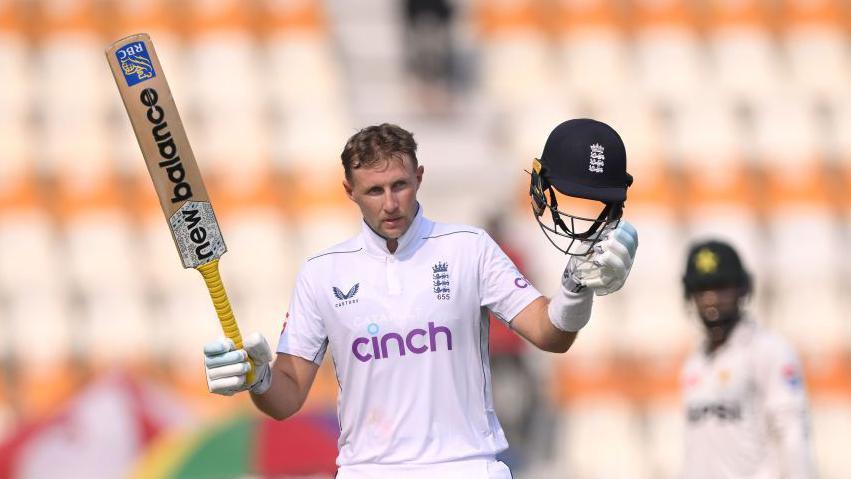Why batting positions matter in cricket
- Published
Who should bat at number three?
It's a question which has been on the lips of England cricket fans since Jonathan Trott retired in 2015.
More than 20 players have attempted to fill the role in the intervening years and, in 2025, the ongoing battle is between Ollie Pope and Jacob Bethell.
For Australia, the conundrum is how to replace David Warner at the top of the order. Usman Khawaja had five different partners in the first 12 Tests without veteran opener Warner alongside him.
Similar debates have been raging around the world since cricket began, the only change being the names in question.
But why do batting positions matter in cricket?
Get in touch
Send us your questions
What are the different batting positions?
Batting positions are split into three broad categories.
The top order refers to players who bat at numbers one, two and three.
The middle order covers positions four to seven.
The lower order is made up of positions eight to 11. Lower-order batters, particularly those with little scoring prowess, are also known as tail-enders.
Top-order batters are the "engine room" of the line-up,, external according to former Australia international Matthew Hayden, tasked with getting the team off to a positive start, seeing off the new ball and, ideally, anchoring the innings by staying at the crease for a long time.
Opening the batting - i.e. numbers one and two - is a specialist position.
The middle order contains players with the ability to change an innings, with their role dependent on how the players before them have performed.
They may have to anchor or rebuild an innings if there's been a top-order collapse; attack to push the game on (particularly in limited-overs matches when there's less time to make an impact); bat with the tail and control the strike rotation to either take on the run-scoring responsibility or protect a weaker batter from facing too many deliveries; or face the second new ball (which the bowling team can request after 80 overs).
In short, versatility and adaptability are key.
Players in the lower order are the weaker batters in the team, usually made up of the bowlers or young players yet to prove themselves. They may play defensively and block every ball or swing at everything as they have nothing to lose.
If a wicket falls towards the end of a day's play, a good defensive player from the lower order may be promoted up the order as a nightwatchman.
Their mission is to defend the remaining deliveries to prevent better players from batting - and potentially getting out - in challenging conditions.

Joe Root - England's leading Test run-scorer - bats at number four
Different roles, different skills
What makes a player suited to a particular position? There are numerous factors to consider, including the ball, the pitch, and a player's mentality.
Top-order batters are among the most proficient in the XI and bat during the trickiest period, namely against the new ball and the frontline bowlers.
The new ball is hard, shiny and has a prominent seam, enabling bowlers to swing it through the air and extract significant bounce and movement off the pitch.
Over time, the ball becomes softer and rougher and the pitch deteriorates, providing grip and movement for spin bowlers. Middle-order batters, therefore, are ideally good players of spin and strong defensively.
Former England captain Michael Vaughan says "in this era" the best batter in the XI bats at number four, external - think Joe Root, Steve Smith or Virat Kohli.
These players, who are expected to act as the backbone of an innings, are comfortable against pace and spin but benefit from protection from the new ball and easier conditions if the top three do their job.
Opening batters also face the physical and mental challenge of getting little rest between bowling and batting innings, and being prepared to bat for long periods of time. All-rounders and wicketkeepers, by contrast, often bat in the middle order to ensure extra recovery time between innings.
However, arguably the most challenging position from a mental perspective - and where the likes of Don Bradman and Viv Richards scored the bulk of their runs - is number three.
Listing the attributes of a number three, external, Vaughan said they are a "pillar of calm and control" who can "soak up pressure and put it back on the bowler".
Former Australia international Ian Chappell says "if you aren't mentally attuned to going in early then number three is not the spot for you".
These players may be called upon in the first over if an opener is dismissed early or have to wait all day if a partnership builds.
Alluding to the mental challenge of batting at three, Root has previously stated that one of the reasons he dropped back down to number four during his time as Test captain was the extra time it gave him to switch his focus from captaincy to batting between innings.
This article is the latest from BBC Sport's Ask Me Anything team.
What is Ask Me Anything?
Ask Me Anything is a service dedicated to answering your questions.
We want to reward your time by telling you things you do not know and reminding you of things you do.
The team will find out everything you need to know and be able to call upon a network of contacts including our experts and pundits.
We will be answering your questions from the heart of the BBC Sport newsroom, and going behind the scenes at some of the world's biggest sporting events.
Our coverage will span the BBC Sport website, app, social media and YouTube accounts, plus BBC TV and radio.